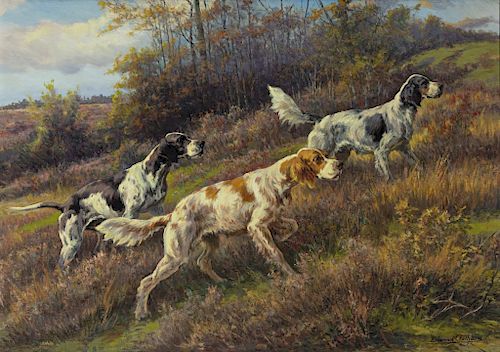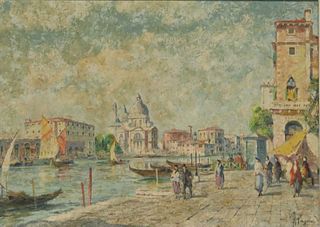Edmund H. Osthaus (1858-1928) On Point, Up Hill
Lot 9
About Seller
Copley Fine Art Auctions
20 Winter Street
Pembroke, MA 02359
United States
Founded in 2005, Copley Fine Art Auctions is a boutique auction house specializing in antique decoys and American, sporting, and wildlife paintings. Over the course of the last two decades, the firm has set auction records for not only individual decoy makers, but also entire carving regions. Copley...Read more
Estimate:
$30,000 - $50,000
Absentee vs Live bid
Two ways to bid:
- Leave a max absentee bid and the platform will bid on your behalf up to your maximum bid during the live auction.
- Bid live during the auction and your bids will be submitted real-time to the auctioneer.
Bid Increments
| Price | Bid Increment |
|---|---|
| $0 | $50 |
| $1,000 | $100 |
| $2,500 | $250 |
| $5,000 | $500 |
| $10,000 | $1,000 |
| $25,000 | $2,500 |
| $50,000 | $5,000 |
About Auction
By Copley Fine Art Auctions
Jul 25, 2019
Set Reminder
2019-07-25 10:00:00
2019-07-25 10:00:00
America/New_York
Bidsquare
Bidsquare : The Sporting Sale 2019
https://www.bidsquare.com/auctions/copley/the-sporting-sale-2019-4227
July 25 at 10 am | 550 lots Copley Fine Art Auctions cinnie@copleyart.com
July 25 at 10 am | 550 lots Copley Fine Art Auctions cinnie@copleyart.com
- Lot Description
Edmund H. Osthaus (1858-1928)
On Point, Up Hill
signed "Edmund Osthaus" lower right
oil on canvas, 24 by 36 in.
Edmund Henry Osthaus was born in Hildesheim, Germany, in 1858, the son of a prosperous farmer who subsequently emigrated to Toledo, Ohio. Osthaus studied at the Royal Academy of the Arts in Dusseldorf from 1874 to 1882 with Andreas Muller, Peter Jansen, Eduard von Gebhardt, Ernst Deger, and wildlife and landscape painter Christian Kroner. In 1883, after studying painting for six years, Edmund Osthaus became an instructor at the Toledo Academy of Fine Arts. He served as the director from 1886 to 1893, refining his painting technique and pursuing his passions: hunting and fishing.
In 1893 Osthaus dedicated his full attention to painting, shooting, and field trials. He was a charter member of the National Field Trial Association established in Newton, North Carolina, in 1895. “Edmund Osthaus followed field trials from the fall prairie chicken trials in Canada to the important quail trials in the South in mid-winter, judging, sketching, and sometimes entering his dogs. He was a handsome, powerfully built man," and his artistic talent combined with his love of dogs enabled him to capture the essence of the focused working dog while depicting them in precise anatomical detail.
"Any painter who paints for shooting men had better be a shooting man himself, for no one is more jealously critical of detail than the man who knows guns and dogs and game...Edmund Osthaus, who trained and shot over his own setters and pointers, transformed oil paint into dog flesh quivering under the stress of a point."
This painting, depicting three hunting dogs who have found their quarry, is among Osthaus' finest work. The exquisite detail in the faces of the dogs and the quality of the balanced, painterly landscape in the background yields two paintings in one: a landscape and a stunning sporting dog painting, with all the hallmarks of Edmund Osthaus at his best.
Provenance: Collection of Jim and Diane Cook
Literature: Kay and George Evans, "Dogs that Live Forever," Field & Stream, Vol. LXXV, No. 2, June 1970, pp. 234-240.Please email condition report requests to leah@copleyart.com. Any condition statement given is a courtesy to customers, Copley will not be held responsible for any errors or omissions. The absence of a condition statement does not imply that the lot is in perfect condition.Condition
- Shipping Info
-
Shipping info
Copley Fine Art Auctions does not handle the shipping of any items. Shipping is the sole responsibility of the buyer. Once your payment has cleared, and we have received your authorized shipping release form items may be released for shipment. Copley Fine Art Auctions, LLC shall have no liability for any loss or damage to such items. Buyers should allow up to four weeks for shipment.Please be aware that internet bidders may NOT not pick up their items at the sale. Items will be available for pick up by appointment or by shippers five days after the sale.
-



 EUR
EUR CAD
CAD AUD
AUD GBP
GBP MXN
MXN HKD
HKD CNY
CNY MYR
MYR SEK
SEK SGD
SGD CHF
CHF THB
THB













